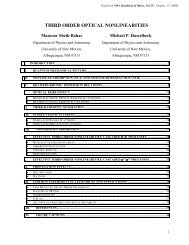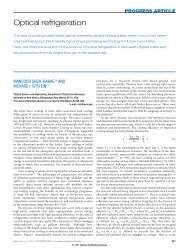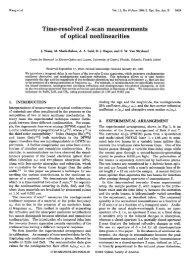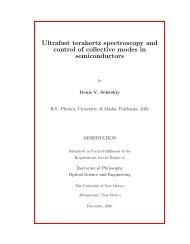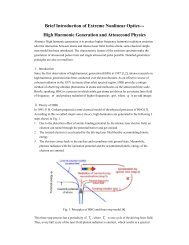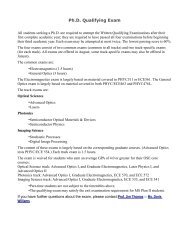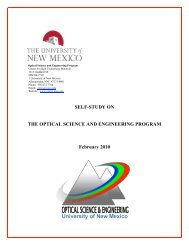Absorption spectra of wide-gap semiconductors in their ...
Absorption spectra of wide-gap semiconductors in their ...
Absorption spectra of wide-gap semiconductors in their ...
Create successful ePaper yourself
Turn your PDF publications into a flip-book with our unique Google optimized e-Paper software.
Optics Communications 227 (2003) 337–341<br />
www.elsevier.com/locate/optcom<br />
<strong>Absorption</strong> <strong>spectra</strong> <strong>of</strong> <strong>wide</strong>-<strong>gap</strong> <strong>semiconductors</strong><br />
<strong>in</strong> <strong>their</strong> transparency region<br />
Babak Imangholi * , Michael P. Hasselbeck, Mansoor Sheik-Bahae<br />
Optical Science and Eng<strong>in</strong>eer<strong>in</strong>g Program, Department <strong>of</strong> Physics and Astronomy, University <strong>of</strong> New Mexico,<br />
Albuquerque, NM 87131, USA<br />
Received 28 July 2003; received <strong>in</strong> revised form 12 September 2003; accepted 15 September 2003<br />
Abstract<br />
The l<strong>in</strong>ear absorption <strong>spectra</strong> <strong>of</strong> GaP, TiO 2 , ZnSe, and ZnS are measured <strong>in</strong> <strong>their</strong> transparency range us<strong>in</strong>g a twocolor,<br />
excite-probe Z-scan. ZnS has the lowest absorption coefficient (10 5 cm 1 ) <strong>in</strong> the wavelength range 840–900 nm,<br />
mak<strong>in</strong>g it an excellent material for use as a lum<strong>in</strong>escence extract<strong>in</strong>g lens <strong>in</strong> semiconductor laser cool<strong>in</strong>g experiments.<br />
Direct observation <strong>of</strong> two-photon absorption <strong>in</strong> ZnSe us<strong>in</strong>g only low power, cont<strong>in</strong>uous laser beams is also reported.<br />
Ó 2003 Elsevier B.V. All rights reserved.<br />
PACS: 78.20.Ci; 78.20.Nv; 42.70.Km; 42.65Jx<br />
Keywords: Laser cool<strong>in</strong>g; Optical refrigeration; Two-photon absorption; ZnS; ZnSe; TiO 2 ; GaP; II–VI compounds; Z-scan; Thermal<br />
refraction<br />
A solid is generally considered to be transparent<br />
at wavelengths longer than its electronic absorption<br />
resonances. <strong>Absorption</strong> <strong>in</strong> the transparency<br />
<strong>spectra</strong>l region can be very small, but it is not<br />
exactly zero. Reported here are measurements <strong>of</strong><br />
absorption coefficients for materials considered<br />
to be transparent <strong>in</strong> the wavelength range 840 <<br />
k < 900 nm and hav<strong>in</strong>g a refractive <strong>in</strong>dex close to<br />
GaAs (n ¼ 3:6). Such substrates will be essential<br />
for efficient photolum<strong>in</strong>escence extraction <strong>in</strong> GaAs<br />
heterostructures, which is a crucial issue <strong>in</strong> laser<br />
cool<strong>in</strong>g <strong>of</strong> <strong>semiconductors</strong>.<br />
* Correspond<strong>in</strong>g author. Tel.: +1-505-277-3301; fax: +1-505-<br />
277-1520.<br />
E-mail address: babak@unm.edu (B. Imangholi).<br />
Laser cool<strong>in</strong>g <strong>of</strong> <strong>semiconductors</strong> is based on a<br />
three-step process: (i) an <strong>in</strong>cident photon with energy<br />
less than the mean lum<strong>in</strong>escence energy is<br />
absorbed, (ii) the excitation thermalizes with the<br />
lattice through phonon absorption, and (iii) lum<strong>in</strong>escence<br />
<strong>of</strong> higher energy photons occur. Anti-<br />
Stokes lum<strong>in</strong>escence causes a net temperature<br />
reduction <strong>of</strong> a solid provided the up-conversion<br />
process is efficient, the lum<strong>in</strong>escence can be efficiently<br />
extracted, and negligible parasitic heat<strong>in</strong>g<br />
occurs <strong>in</strong> the sample or substrate. Laser cool<strong>in</strong>g has<br />
been observed <strong>in</strong> rare-earth doped solids [1] but its<br />
realization <strong>in</strong> <strong>semiconductors</strong> has been h<strong>in</strong>dered,<br />
primarily due to lum<strong>in</strong>escence trapp<strong>in</strong>g [2].<br />
We address the lum<strong>in</strong>escence trapp<strong>in</strong>g problem<br />
by plac<strong>in</strong>g a dome lens on the surface <strong>of</strong> the GaAs<br />
0030-4018/$ - see front matter Ó 2003 Elsevier B.V. All rights reserved.<br />
doi:10.1016/j.optcom.2003.09.044
338 B. Imangholi et al. / Optics Communications 227 (2003) 337–341<br />
Fig. 1. Laser cool<strong>in</strong>g schematic with dome lens mounted on<br />
semiconductor heterostructure.<br />
heterostructure (see Fig. 1). This is the usual approach<br />
<strong>in</strong> the design <strong>of</strong> efficient light-emitt<strong>in</strong>g diodes.<br />
The requirement for a small absorption<br />
coefficient (a) <strong>in</strong> nearly <strong>in</strong>dex matched lens material<br />
motivated the present work. GaAs has a<br />
nom<strong>in</strong>al mean lum<strong>in</strong>escence wavelength <strong>of</strong> 860 nm<br />
at 300 K. The dome lens radius is 0:5 < R < 1cm<br />
and the material from which it is made must have<br />
aR < 10 3 cm 1 [3]. We evaluate the <strong>wide</strong>-<strong>gap</strong><br />
materials ZnS, ZnSe, TiO 2 , and GaP <strong>in</strong> the<br />
wavelength range 840–900 nm for suitability as a<br />
dome lens. Although all candidate materials have<br />
band<strong>gap</strong> energy much greater than GaAs, the<br />
presence <strong>of</strong> uncontrolled impurities leads to a<br />
small but measurable amount <strong>of</strong> background absorption<br />
<strong>in</strong> the near-<strong>in</strong>frared. We f<strong>in</strong>d that ZnSe<br />
(a 8 10 4 cm 1 ) and ZnS (a 6 10 5 cm 1 )<br />
have acceptable absorption at the mean lum<strong>in</strong>escence<br />
wavelength <strong>of</strong> GaAs. The refractive <strong>in</strong>dex <strong>of</strong><br />
ZnS (n ¼ 2:4) results <strong>in</strong> a critical angle <strong>of</strong> 45° at<br />
the semiconductor–lens <strong>in</strong>terface and an estimated<br />
lum<strong>in</strong>escence output coupl<strong>in</strong>g efficiency <strong>of</strong> 22%<br />
[3].<br />
There are several methods for measur<strong>in</strong>g very<br />
small absorption coefficients, <strong>in</strong>clud<strong>in</strong>g cavity r<strong>in</strong>g<br />
down spectroscopy [4]. Here, we use a two-color<br />
Z-scan that detects thermally <strong>in</strong>duced refractive<br />
<strong>in</strong>dex changes with little sensitivity to background<br />
noise [5]. S<strong>in</strong>ce it is an opto-thermal technique, this<br />
approach is most suitable for our laser cool<strong>in</strong>g<br />
application. The experimental schematic is depicted<br />
<strong>in</strong> Fig. 2. Pump light from a tunable, near<strong>in</strong>frared<br />
cw Ti:sapphire laser (power 1.5 W) is<br />
modulated with a mechanical chopper to allow<br />
lock-<strong>in</strong> detection. A thermal lens is created due to<br />
the Gaussian spatial pr<strong>of</strong>ile <strong>of</strong> the pump and<br />
temperature-dependent <strong>in</strong>dex <strong>of</strong> refraction <strong>of</strong> the<br />
material. The probe beam is a low power, cw He–<br />
Ne laser (
B. Imangholi et al. / Optics Communications 227 (2003) 337–341 339<br />
the pump irradiance. Changes <strong>in</strong> the probe beam<br />
divergence are monitored by a detector placed<br />
beh<strong>in</strong>d a partially obscur<strong>in</strong>g aperture <strong>in</strong> the farfield.<br />
The size <strong>of</strong> the aperture is set for 10%<br />
transmission <strong>of</strong> the He–Ne probe beam.<br />
The two-color technique gives enhanced sensitivity<br />
compared to a s<strong>in</strong>gle beam Z-scan where<br />
there can be distortion and measurement noise<br />
associated with surface imperfections. This occurs<br />
because a s<strong>in</strong>gle laser beam encounters nonuniformities<br />
as its spatial pr<strong>of</strong>ile changes dur<strong>in</strong>g<br />
sample translation. Background subtraction can<br />
reduce this, but a non-ideal surface still limits the<br />
measurement accuracy. An excite-probe arrangement<br />
with lock-<strong>in</strong> detection can provide a greatly<br />
enhanced signal-to-noise ratio [5]. We are able to<br />
measure transmittance changes <strong>of</strong>
340 B. Imangholi et al. / Optics Communications 227 (2003) 337–341<br />
curves. Read<strong>in</strong>g left-to-right, all the data display a<br />
negative differential transmission followed by a<br />
peak. This is the signature <strong>of</strong> self-focus<strong>in</strong>g associated<br />
with a thermally <strong>in</strong>duced change to the refractive<br />
<strong>in</strong>dex. The dataset for GaP has a very high<br />
signal-to-noise ratio, but shows some deviation<br />
from the calculated curve at displacements far<br />
from z ¼ 0. We attribute this to aberrations <strong>in</strong>troduced<br />
by the pump focus<strong>in</strong>g lens that prevent<br />
realization <strong>of</strong> an ideal Gaussian beam. Material<br />
parameters relevant for our analysis are shown <strong>in</strong><br />
Table 1; this <strong>in</strong>formation is primarily obta<strong>in</strong>ed<br />
from the manufacturers. Extracted l<strong>in</strong>ear absorption<br />
coefficients <strong>in</strong> the wavelength range 840–900<br />
nm are displayed <strong>in</strong> Fig. 4. TiO 2 is known to have<br />
birefr<strong>in</strong>gence <strong>in</strong> the near-<strong>in</strong>frared [7], but we are<br />
unable to detect changes <strong>in</strong> the response when the<br />
sample is rotated on its azimuth.<br />
The ZnSe data are corrected for the presence <strong>of</strong><br />
two-photon absorption (TPA). This nonl<strong>in</strong>ear<br />
optical phenomenon can occur via two different<br />
physical pathways: (i) absorption <strong>of</strong> two photons<br />
from the Ti:sapphire pump laser (degenerate TPA)<br />
and/or (ii) absorption <strong>of</strong> one near-<strong>in</strong>frared photon<br />
from the Ti:sapphire laser and one visible photon<br />
from the He–Ne probe laser (non-degenerate<br />
TPA). The very low probe power <strong>of</strong> our experiment<br />
and the mode-mismatch condition make the<br />
second process negligible. Degenerate TPA, however,<br />
can become comparable to the l<strong>in</strong>ear absorption<br />
at sufficiently high irradiance. This can be<br />
accounted for by writ<strong>in</strong>g an irradiance-dependent<br />
absorption coefficient<br />
aðI excite ; zÞ ¼a þ 1 2 bI exciteðzÞ;<br />
ð3Þ<br />
<strong>Absorption</strong> Coefficent (cm -1 )<br />
0.33<br />
0.32<br />
0.31<br />
0.30<br />
0.29<br />
0.008<br />
0.006<br />
0.004<br />
0.0012<br />
0.0008<br />
0.0004<br />
8x10 -5<br />
6x10 -5<br />
4x10 -5<br />
GaP<br />
TiO 2<br />
ZnSe<br />
ZnS<br />
840 850 860 870 880 890 900 910<br />
Fig. 4. L<strong>in</strong>ear absorption coefficients for the four materials<br />
studied.<br />
where b is the degenerate TPA coefficient, and<br />
I excite is the on-axis pump <strong>in</strong>tensity at a given position<br />
(z). A geometric factor <strong>of</strong> 1/2 accounts for a<br />
spatially averaged Gaussian pump beam. We<br />
separate l<strong>in</strong>ear from nonl<strong>in</strong>ear absorption us<strong>in</strong>g<br />
the follow<strong>in</strong>g procedure: The sample is translated<br />
to the position <strong>of</strong> maximum differential probe<br />
transmission (i.e., the po<strong>in</strong>t <strong>of</strong> peak signal). The<br />
pump irradiance is then varied to generate the data<br />
shown <strong>in</strong> Fig. 5. Deviations from a l<strong>in</strong>ear response<br />
(solid l<strong>in</strong>e) <strong>in</strong>dicate the presence <strong>of</strong> degenerate<br />
Table 1<br />
Material parameters used <strong>in</strong> the analysis<br />
E g<br />
(eV)<br />
n<br />
j<br />
(W/(cm deg))<br />
C p<br />
(J/(cm 3 deg))<br />
D<br />
(cm 2 /s)<br />
dn=dT<br />
(deg 1 )<br />
ð1=LÞðdL=dT Þ<br />
(deg 1 )<br />
ZnS 3.8 2.4 0.19 1.91 0.099 6.4 10 5 6.497 10 6<br />
ZnSe 2.67 2.46 0.16 1.79 0.089 1.06 10 4 7.57 10 6<br />
TiO 2 3.65 2.9 0.11 3.05 0.036 )5.7 10 7 8.17 10 6<br />
GaP 2.25 3.3 1.1 1.78 0.62 3.3 10 4 4.65 10 6<br />
H 2 O – – 0.6 4.2 0.14 )8 10 5 –<br />
Samples were acquired from Lambda Precision Optics, Costa Mesa, CA (ZnS, ZnSe); Crystallod, Somerville, NJ (TiO 2 ); MTI,<br />
Richmond, CA (GaP).
B. Imangholi et al. / Optics Communications 227 (2003) 337–341 341<br />
Probe Transmittance at Peak (AU)<br />
3.5<br />
3.0<br />
2.5<br />
2.0<br />
1.5<br />
1.0<br />
0.5<br />
0.2 0.4 0.6 0.8 1.0 1.2<br />
Fig. 5. Nonl<strong>in</strong>ear thermal refraction obta<strong>in</strong>ed with ZnSe.<br />
Dotted l<strong>in</strong>e represents model fitt<strong>in</strong>g <strong>in</strong>clud<strong>in</strong>g degenerate twophoton<br />
absorption <strong>of</strong> pump photons. Solid l<strong>in</strong>e is a l<strong>in</strong>ear<br />
extrapolation <strong>of</strong> the low irradiance data.<br />
TPA. When the far-field aperture is removed, the<br />
Z-scan signal will reveal only nonl<strong>in</strong>ear absorption.<br />
This so-called open aperture data are then<br />
subtracted from data taken with a partially<br />
transmitt<strong>in</strong>g aperture to extract the thermal-refraction<br />
signal. The Z-scan data shown <strong>in</strong> Fig. 3<br />
are corrected for nonl<strong>in</strong>ear absorption <strong>in</strong> this way.<br />
Two-photon absorption is a third-order nonl<strong>in</strong>ear<br />
optical process; observation <strong>of</strong> this effect<br />
normally requires large optical electric fields associated<br />
with pulsed, high irradiance laser beams.<br />
Detection <strong>of</strong> TPA with only cw beams is an <strong>in</strong>dication<br />
<strong>of</strong> the high sensitivity <strong>of</strong> our excite-probe<br />
technique. The dotted l<strong>in</strong>e <strong>in</strong> Fig. 5 represents a<br />
calculation that <strong>in</strong>cludes both l<strong>in</strong>ear absorption<br />
and degenerate TPA. We fit the data us<strong>in</strong>g a TPA<br />
coefficient <strong>of</strong> b ¼ 3:2 cm/GW. A value <strong>of</strong> 3.5 cm/<br />
GW was obta<strong>in</strong>ed previously at k ¼ 780 nm by<br />
us<strong>in</strong>g high power, ultrashort laser pulses [8]. A<br />
calculation based on a 3-band model <strong>of</strong> a semiconductor<br />
(light- and heavy-hole valence bands<br />
and a conduction band) yields 2.1 and 3.95 cm/GW<br />
at wavelengths <strong>of</strong> 850 and 780 nm, respectively [9].<br />
No evidence <strong>of</strong> TPA is seen <strong>in</strong> the other materials.<br />
TiO 2 and ZnS are not two-photon resonant<br />
at Ti:sapphire laser wavelengths. The large background<br />
absorption prevents observation <strong>of</strong> TPA <strong>in</strong><br />
GaP. The first report <strong>of</strong> TPA us<strong>in</strong>g cw lasers was<br />
an <strong>in</strong>direct measurement <strong>in</strong>volv<strong>in</strong>g the magnetophotoconductivity<br />
<strong>of</strong> InSb [10]. Here, we make<br />
what we believe is the first direct observation <strong>of</strong><br />
nonl<strong>in</strong>ear transmission <strong>of</strong> a cw laser beam <strong>in</strong>duced<br />
by TPA.<br />
In summary, we have used a sensitive, two-color<br />
Z-scan technique to measure the absorption coefficients<br />
<strong>of</strong> ZnS, ZnSe, TiO 2 , and GaP <strong>in</strong> <strong>their</strong><br />
transparency wavelength range between 840 and<br />
900 nm. We attribute this background l<strong>in</strong>ear absorption<br />
to transitions <strong>in</strong>volv<strong>in</strong>g the Urbach tail<br />
and the presence <strong>of</strong> uncontrolled impurities. It is<br />
found that ZnS has the lowest absorption coefficient,<br />
which makes it suitable for use as a dome<br />
lens to remove lum<strong>in</strong>escence <strong>in</strong> laser cool<strong>in</strong>g experiments<br />
with GaAs. We also observe two-photon<br />
absorption with ZnSe us<strong>in</strong>g only cw laser<br />
beams. In this case, the nonl<strong>in</strong>ear absorption can<br />
be comparable to the background l<strong>in</strong>ear absorption<br />
at sufficiently high irradiance.<br />
Acknowledgements<br />
We acknowledge fund<strong>in</strong>g by NASA Grant<br />
NAG5-10373 and the Air Force Office <strong>of</strong> Scientific<br />
Research.<br />
References<br />
[1] C.W. Hoyt, M.P. Hasselbeck, M. Sheik-Bahae, R. Epste<strong>in</strong>,<br />
S. Greenfield, J. Thiede, J. Distel, J. Valencia, J. Opt. Soc.<br />
Am. B 20 (2003) 1066.<br />
[2] H. Gauck, T.H. Gfroerer, M.J. Renn, E.A. Cornell, K.A.<br />
Bertness, Appl. Phys. A 64 (1997) 143.<br />
[3] M. Sheik-Bahae, R. Epste<strong>in</strong>, Phys. Rev. Lett. (submitted).<br />
[4] A. OÕKeefe, D.A.G. Deacon, Rev. Sci. Instrum. 59 (1988)<br />
2544.<br />
[5] A. Marcano, C. Loper, N. Melekechi, Appl. Phys. Lett. 78<br />
(2001) 3415.<br />
[6] A. Marcano, C. Loper, N. Melekechi, J. Opt. Soc. Am. B<br />
19 (2002) 119.<br />
[7] N.S. Gluck, H. Sankur, J. Heuer, J. Denatale, W.J.<br />
Gunn<strong>in</strong>g, J. Appl. Phys. 69 (1991) 3037.<br />
[8] T.D. Krauss, F.W. Wise, Appl. Phys. Lett. 65 (1994) 1739.<br />
[9] M. Sheik-Bahae, Phys. Rev. B 60 (1999) R11257.<br />
[10] D.G. Seiler, M.W. Goodw<strong>in</strong>, M.H. Weiler, Phys. Rev. B 23<br />
(1981) 6806.


